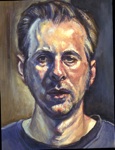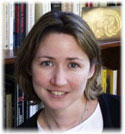Face 2 Face, Transformation Through Art
Professor Brian Kreydatus (Art and Art History) and Professor Silvia Tandeciarz (Hispanic Studies) discussed their work and ideas at an April Face 2 Face conversation, focusing on the transformative influence of art. Following is an abridged version of their conversation. The event was held in a classroom at the College's Andrews Hall.

 Kreydatus began the
conversation by talking about his work and his desire to challenge traditional
understandings of beauty by making the very familiar, unfamiliar.
Kreydatus began the
conversation by talking about his work and his desire to challenge traditional
understandings of beauty by making the very familiar, unfamiliar.
“Over the last year or so, I’ve felt a distinct shift in my work,” said Kreydatus, a painter and printmaker. “I’ve become less interested in work that is obviously about the studio and more interested in images that seem to be about a domestic setting.”
{{youtube:small:right|q7YjSOONV_I}}“I really want to concentrate on the everyday,” Kreydatus continued. “Everyday moments and everyday rituals. I think for most artists there’s this idea of how and why. So much of the beginning of work is about how – how do I draw a figure? As time goes on, more of your work becomes about why. That search for content is a lifelong search for most people.” Kreydatus shared a current self-portrait and spoke about his personal experience with the transition from how to why.
 “Some of the questions I’m thinking about in my work have to do
with how visual culture – art, photography – is different as a medium for
processing trauma and grief, different from narrative, that is,” said
Tandeciarz. Her work focuses on visual initiatives that explore the response to
trauma, particularly the trauma of Argentina's experience with State Terrorism (1976-1983),
when thousands of people disappeared, were murdered, or were tortured in
detention centers.
“Some of the questions I’m thinking about in my work have to do
with how visual culture – art, photography – is different as a medium for
processing trauma and grief, different from narrative, that is,” said
Tandeciarz. Her work focuses on visual initiatives that explore the response to
trauma, particularly the trauma of Argentina's experience with State Terrorism (1976-1983),
when thousands of people disappeared, were murdered, or were tortured in
detention centers.
“I am looking at the work of John Berger, and his idea that art is particularly suited for bringing together that which life has ripped apart,” said Tandeciarz. “The idea of absences, trauma, gaps – how do you process that trauma? Poetry, for example, can help to suture together the pieces to make us whole again. To reach the state of narrative, there has to be some processing that’s happened already. That's where I turn to photography, because it captures something in a particular way that doesn’t yet have language put to it.”
{{youtube:small:left|vNVOJ7XtFwE}} Tandeciarz spoke about an Argentinian woman, Lucila Quieto, whose father was one of the disappeared and who used photography to mend her loss.
Moderator Teresa Longo, Dean for Educational Policy, asked Kreydatus and Tandeciarz to speak more about what is being communicated when the body is removed, either intentionally (by Kreydatus) or through a loss (for Tandeciarz).
“How do you witness something that has taken place in the dark?” asked Tandeciarz. “My work tries to address how you make someone complete who has disappeared. Often what I find most interesting is the notion of trying to make visible what hasn’t been visible or seen. We need something to direct our attention to in order to effect some kind of change.” Art can act as a place to focus attention when a person is gone.
{{youtube:small:right|fdzFnjR-d0I}}Kreydatus shared an image he painted at night while his family was asleep and spoke about how this got him thinking about his work with the absence of a defining figure.
“The idea of showing all the things without actually showing the figure would make you recall it in a way that would be more specific and universal at the same time,” said Kreydatus. “Specific, because of the things that are shown and the space they are in; and a bit more universal, because there is no particular person.”
“I’d like to hear Brian talk about processing strong emotion through art. It seems like you are working through both personal and collective issues in your work,” said Tandeciarz.
Kreydatus replied, “If you are going to have any sort of sustained interest in art, it has to be something that you are obsessed with, and that’s all you think about all the time. These interests, whether they are body image or strong emotions, that’s where my interests lie. When I’ve tried to do something else, it isn’t interesting enough to continue. I’ve come to grips with the fact that most of my work is about my own life, which can be kind of odd – to put yourself out there, or your wife, or your children.”
Kreydatus asked Tandeciarz if she had looked at art in media other than photography, and how it is different or the same.
{{youtube:small:left|jmLOqxe_4kI}}“I have looked at sculpture at memorial parks and film,” said Tandeciarz. “What’s different about photography, there is much more space, more framing for you to bring different modes of engagement with the individual. When you take a photograph, that is more instantaneous in terms of capturing something.” She spoke about other differences as well.
“There is so much beauty in this work, and in its power to heal,” said Tandeciarz. “It is amazing to see the ability of a human being to heal and transform through art.”














